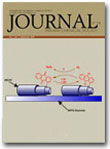فهرست مطالب

Journal of the Iranian Chemical Society
Volume:2 Issue: 1, Mar 2005
- تاریخ انتشار: 1383/12/15
- تعداد عناوین: 9
-
Page 1We present an overview of the electrochemical reduction of oxygen in water, focussing on carbon-based and modified carbon electrodes. This process is of importance for gas sensing, in fuel cells and in the electrosynthesis of hydrogen peroxide.
-
Page 26The conventional electrophoresis methods are well known techniques for protein detection and analysis of cerebrospinal fluid (CSF). Disc electrophoresis (DEP) was carried out for detection of oligoclonal IgG bands in cerebrospinal fluid (CSF) on polyacrilamide gel. However, the advance of automation has made rapid collection of large amounts of data feasible and the development of microcomputers has made sophisticated processing even of old electrophoregrams possible. Automated analysis, data storage and sophisticate data acquisition were carried out with Gel Pro Analyzer 3.1, which is specifically structured to analyze gels and elctrophoregrams: complex band pattern matching (gel variation, dendogram analysis etc.); lane relation studies (sophisticated lane database); general gel analysis (accurate molecular size, quantitative determination of protein mixture etc.). Clustering techniques have been applied for detection of intrathecal immune response. Different hierarchic cluster analysis methods such as single linkage, complete linkage, unweighted pair-group average (UPMGA) were used. In addition, other cluster characteristics such, distance matrix and Euclidean distance matrix were calculated. Pairing of electrophoresis methods and cluster image analysis, could lead to additional diagnostic information of inflammatory conditions of the central nervous system (CNS) or dysfunction of blood-CSF barrier.
-
Page 32A method for the determination of nickel(II) by stripping voltammetry is described. The method is based on the adsorptive accumulation of nickel(II) calconcarboxylic acid complex onto a hanging mercury drop electrode (HMDE), followed by the reduction of the adsorbed complex using differential pulse voltammetry. The optimum operating conditions and parameters were found to be 0.05 M NH3/NH4Cl buffer (pH = 9.5) as the supporting electrolyte, a ligand concentration of 1 × 10-6 M, accumulation potential of -0.5 V (vs. Ag/AgCl) and accumulation time of 60 s. At the optimized conditions, the peak current is proportional to the concentration of nickel in the range of 1.7 × 10-9 to 4.7 × 10-7 M (0.1-28 ng ml-1) with a detection limit of 0.05 ng ml-1. The relative standard deviation (n = 10) at nickel concentrations of 2, 10 and 15 ng ml-1 varies in the range 0.76 to 2.1%. Possible interferences by metal ions, which are of great significance in real matrices, have been studied. The method was successfully applied to the determination of nickel content in a chocolate sample.
-
Page 40Some metal complexes of Schiff bases have been prepared by the interactions of palladium(II) and platinum(II) chloride with 5-chloro-1,3-dihydro-3-[2-(phenyl)- ethylidene]-2H-indol-2-one-hydrazinecarbothioamide(L1H) and 5-chloro-1,3-dihydro-3- [2-(phenyl)-ethylidene]-2H-indol-2-one- hydrazinecarboxamide(L2H), in bimolar ratios. All the new compounds have been characterized by elemental analyses, conductance measurements, molecular weight determinations, IR and 1H NMR spectral studies. The spectral data are consistent with a square planar geometry around Pd(II) and Pt(II) in which the ligands act as neutral bidentate and monobasic bidentate ligands, coordinating through the nitrogen and sulfur/oxygen atoms. Free ligands and their metal complexes were screened for their antimicrobial activity on different species of pathogenic fungi and bacteria and their biopotency has been discussed.
-
Page 47A useful method for direct sulfonylation of phenols with p-toluenesulfonic acid in the presence of Al2O3/MeSO3H system has been described.
-
Page 54A new phase of titanium phosphate with a highly organized porous framework has been synthesized by a non-thermal digestion method. FTIR، TGA-DTA، XRD and SEM have been employed to study the primary product، calcined and digested materials. Pore diameters in the range of 22-90 Å have been obtained for the digested material as determined by nitrogen absorption measurements. Quantitative removal of copper (II) phthalocyanine and its derivative from aqueous medium have been achieved.
-
Page 60Multi-walled carbon nanotubes (MWCNTs) have been chemically derivatised via the reduction of anthraquinone-1-diazonium chloride with hypophosphorous acid to attach 1-anthraquinonyl groups to the MWCNTs, most likely at edge plane like defects. The covalently attached quinone moiety attached to the nanotubes (''molecular wire'') acts as an effective mediator for the electrocatalytic reduction of oxygen.
-
Page 65The acidity constants of some carboxylic acids in aqueous solution have been calculated. The calculations were carried out using Möller-Plesset (MP) perturbation theory. The Polarizable Continuum Model (PCM) is used to describe the solvent. This model furnishes pKa values that agree more closely with experimental data than those obtained at the level of Hartree-Fock (HF) and Density Functional Theory (DFT-B3LYP). The root-mean-square of errors of the calculated pKa values are less than 1.0 for the studied acids. The molecules analyzed consist of acids with pKa values in the range of 1.30 to 5.05, and have been partitioned into three classes. Class I includes acids with pKa values higher than 4.00. Class II includes strong acids with pKa values between 3.00 to 4.00. Class III includes very strong acids with pKa values less than 3.00. The calculated pKa values for the acids in Class I and Class II agree more closely with experimental values. The root-mean-square of errors for the Class I and Class II compounds are 0.70 and 0.78 pKa units, respectively.
-
Page 71Studies were made on oscillations across a liquid membrane consisting of an oil layer, octanol containing barbitone, between two aqueous layers: one containing 8 mM SDS with alcohol and the other containing 0.1 M NaCl. The effects of various concentrations of chemical components in this system on the patterns of electrical oscillation were examined. The oscillations may be explained by the mechanism of repetitive formation and destruction of monolayer structures of the dodecyl sulfate anion at the interface between the organic and the aqueous phases, with the effect of proton penetration. This study of potential oscillation across a membrane containing a drug provides the possibility of further investigations in pharmacological activity.

